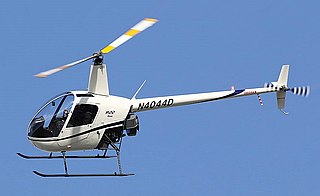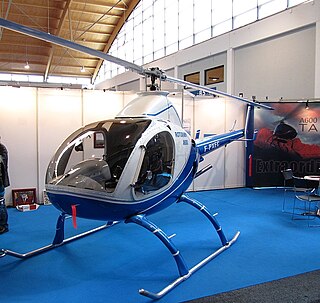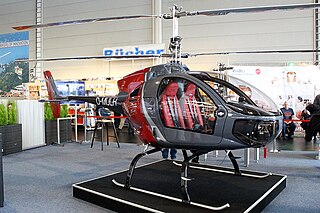The Robinson Helicopter Company, based at Zamperini Field in Torrance, California, is an American helicopter manufacturer. As of 2024, Robinson produces three models: the two-seat R22, the four-seat R44, both of which use Lycoming piston engines, and the five-seat R66, which use Rolls-Royce turbine engines.

The Robinson R22 is a two-seat, two-bladed, single-engined, light utility helicopter manufactured by Robinson Helicopter Company. It was designed in 1973 by Frank D. Robinson, and has been in production since 1979.

The Mil Mi-6, given the article number izdeliye 50 and company designation V-6, is a Soviet/Russian heavy transport helicopter that was designed by the Mil design bureau. It was built in large numbers for both military and civil use and was the largest helicopter in production until the Mil Mi-26 was put in production in 1980.

The Sikorsky S-67 Blackhawk was a private-venture, prototype attack helicopter built in 1970 with Sikorsky Aircraft research and development (R&D) funds. A tandem, two-seat aircraft designed around the dynamic drive and rotor systems of the Sikorsky S-61, it was designed to serve as an attack helicopter or to transport up to eight troops into combat.

The Hughes TH-55 Osage is a piston-powered light training helicopter produced for the United States Army. It was also produced as the Model 269 family of light utility helicopters, some of which were marketed as the Model 300. The Model 300C was produced and further developed by Schweizer after 1983.

The Lockheed XH-51 was an American single-engine experimental helicopter designed by Lockheed Aircraft, utilizing a rigid rotor and retractable skid landing gear. The XH-51 was selected as the test vehicle for a joint research program conducted by the United States Army and United States Navy to explore rigid rotor technology.

The Brantly B-2 is an American two-seat light helicopter produced by the Brantly Helicopter Corporation.

The Helicycle is a single-seat, semi-rigid two-bladed main rotor, helicopter powered by a Solar T62-32 engine. Manufactured by Helicycle Ventures LLC in Mesilla, New Mexico as a kit, the aircraft is intended to be assembled by the owner and is considered a homebuilt aircraft. The Helicycle was conceived and designed by B.J. Schramm, the founder of RotorWay International.

The Robinson R66 is a helicopter designed and built by Robinson Helicopter Company. It has five seats, a separate cargo compartment and is powered by a Rolls-Royce RR300 turboshaft engine. The R66 is slightly faster and smoother than the Robinson R44 from which it is derived. The R66 received both type and production certificates from the U.S. Federal Aviation Administration (FAA) on October 25, 2010.

The Guimbal Cabri G2 is a two-seat light helicopter produced by Hélicoptères Guimbal, and powered by a reciprocating engine. Designed by Bruno Guimbal, a former Eurocopter engineer, it had its origins in the 1980s, and the first demonstrator flew in 1992. Following the granting of regulatory approval, the Cabri entered commercial service in 2008. In addition to its use within the general aviation sector and as a training rotorcraft, the Cabri G2 has also been used as the basis for unmanned aerial vehicles (UAVs).

The Cicaré CH-7 and Heli-Sport CH7 are a series of ultralight, kit-built helicopters based on a single-seat Argentinian design from the late 1980s. It was later developed into a tandem two-seater, and remains in production.
The Famà Kiss 209M is an Italian ultralight two-seat helicopter, built from composite materials around a steel frame and with an optional retractable undercarriage. The moniker "Kiss" stands for "keep it stupidly simple", reflecting the philosophy of its designer, Nino Famà.
The Skyline SL-222 is a three-bladed, twin-engined light utility helicopter developed by the Ukrainian company Skyline. It made its first flight in 2011 and is intended to compete on the civil market in the same low-cost category as the popular Robinson R22.

The RotorWay A600 Talon is an American helicopter, designed and produced by RotorWay International of Chandler, Arizona. The aircraft is supplied as a kit for amateur construction.

The Enstrom TH180 is a single piston-engined two-place training helicopter manufactured by Enstrom in the United States.
The Midwest Zodiac Talon-Turbine is an American helicopter that was designed and produced by Midwest Engineering & Design of Overland Park, Kansas. When it was available the aircraft was supplied in the form of plans for amateur construction, but the plans are no longer advertised for sale.
The Pawnee Chief is an American helicopter that was designed and produced by Pawnee Aviation of Longmont, Colorado and later McCook, Nebraska. It was first flown in December 2005. Now out of production, when it was available the aircraft was supplied as a kit for amateur construction.
The Aero Eli Servizi Yo-Yo 222 is an Italian helicopter designed and produced by Aero Eli Servizi of L'Aquila. The aircraft is supplied complete and ready-to-fly.

The Heli-Sport CH77 Ranabot is an Italian helicopter designed and produced by Heli-Sport of Turin. The aircraft is supplied as a kit for amateur construction.

The EDM Aerotec CoAX 2D/2R is a series of German coaxial main rotor helicopters designed and produced by EDM Aerotec of Geisleden. The aircraft is supplied complete and ready-to-fly.




















